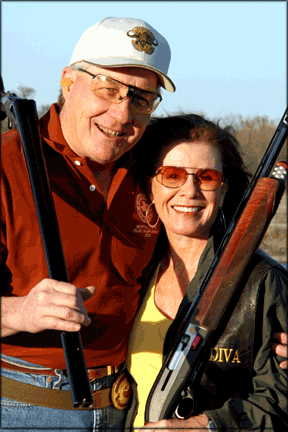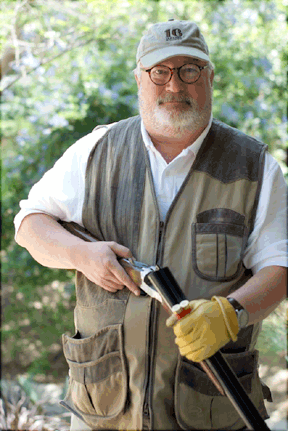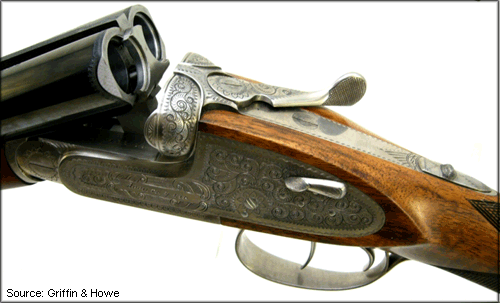This is the third installment of our occasional series on DIVA, Women Outdoors Worldwide.
While there are certainly plenty of women in the great state of Texas who own a gun, Cheryl Long is special among them. That’s because she’s the current president of the organization, DIVA Women Outdoors Worldwide.
DIVA is thoroughly dedicated to encouraging and mentoring women of all ages in the shooting sports. For more than 10 years through successful clinics for women and youth across the USA, this unique organization has introduced more than 3,000 women to the shooting sports.
And so it only makes sense that a devoted gun enthusiast like Cheryl takes the helm of DIVA. It also makes sense that the group was formerly known as Texas Women’s Shooting Sports, since Cheryl and her husband, Denny, love to hunt quail, dove, duck and mule deer on their leased 12,000 acre spread in west Texas.
Cheryl came into the world of shotguns and hunting from a fairly unusual start.
“I sang with a band called Maya for 20 years in Oklahoma City,” she recalled.
She subsequently became acquainted with shooting when she moved from Oklahoma City to Texas 1992. She had moved to Texas because of the big “L,” love.
“I had fallen in love with this gentleman who was very big into hunting and who was just an overall shooting enthusiast,” she said. “At the time, I didn’t know a thing about guns, and really, I was afraid of them.”
Still, she was swept off her feet and onto the alter.
As proof that love conquers all, despite her fear of guns, she stuck by her man even though there were loaded guns stashed all over their house. “They [guns] were there for home protection and the occasional coyote and skunk.”
Eventually, Cheryl was talked into her first shooting experience by her husband. He handed her a Smith & Wesson .357 pistol and told her to hit the target. Without having any ear protection, the boom of that first shot only served to frighten her all over again. But she didn’t give up.
The turning point for Cheryl was a Dallas Safari Club convention where she found an instructor who offered an intensive two-day course in shooting. Shortly afterward, she purchased her very own first gun, a Glock 17 9mm. This Glock took her on a journey from someone who was frightened of guns to where she reached the point that she could speed shoot from the holster and sometimes “beat the men,” she said.
It was during this time as a crackerjack pistol shot that Cheryl was introduced to shotguns.
There was a one-year anniversary soiree in 1998 of the Beretta Gallery in Dallas, and she attended the reception. She registered for the door prize and sure enough won a 20-gauge Beretta 390. She was elated…until she tried shooting the gun.
“I shot horribly,” she recalled. “I tried to get better, but couldn’t.”
It turned out that the main problems were eye dominance and gun fit. Her first instructor, Gaylen Capps, recognized that she was a right-handed shooter, but left-eye dominant. He had mentioned the eye dominance issue and suggested using Chapstick on the left lens…but that was way too messy for Cheryl and she really didn’t understand the importance of seeing the targets with the right eye…the SHOOTING eye.
After learning this important piece of information, she got that Beretta 390 fitted to her and started using a patch on her left eye to shift the dominance to her right one. As usual, there was no stopping Cheryl after that.
She started taking lessons from the greats such as Andy Duffy and Dan Carlisle, and made it into B Class for sporting clays.
As Cheryl’s sporting clays career began its ascent, she had a terrible and unfortunate turn of events. Her beloved husband passed away in 2003. Now a woman shooting on her own, she decided to join the Dallas Gun Club to find other people to shoot with.
Fate would intervene…
In 2005, a mutual friend introduced her to Denny Long. Their friend told Cheryl, “You have to meet this guy. He’s single, he’s fun and he’s a great shot and I think you’ll be wonderful together.”
They went on their first date that Memorial Day weekend. “I thought he was OK,” Cheryl confided. “He didn’t have much to say and he didn’t call me, and I didn’t think much about it because he didn’t make much of an impression.” That was about to change.
It was about three weeks later that Cheryl went with one of her girlfriends to Backwoods Gun Range (sadly now closed) north of Dallas to practice skeet for an upcoming league at Dallas Gun Club.
“There was Denny,” she said. “When my girlfriend and I were finished with practice and about to leave, he convinced us to get to get into his 1949 Willys Jeep named Nellybelle and join him for some sporting clays. We had the best time, we laughed, had a lot of fun. We’ve been inseparable since then. We’ve been married three years now.”

Cheryl and Denny Long
For their honeymoon, they went to South Africa to hunt kudu, blue wildebeest and impala. Last month, she and Denny went to Argentina with DIVA founder, Judy Rhodes and a bunch of her closest friends in the Provence of Cordoba at an estancia operated by SYC Sporting Adventures.
“We hunt a lot and love it,” Cheryl said.
Cheryl has graduated up from her 20-gauge Beretta 390, which she still uses for birds, to a 12-gauge Beretta Urika 391 for all other shotgun sports.
By her own admission, the Urika 391 is chock full of aftermarket bling including a Briley action closer button and forend cap (both in red), Briley titanium chokes and a dropped and a canted stock by Ken Rucker of Speedbump Stockworks. Her initials are engraved on the receiver by a renown Italian engraver. And DIVA TEAM is proudly displayed on the barrel.
Now most of her life is tied up hunting with Denny and staying involved with the DIVA WOW.
“DIVA has done so much for me,” she explained. “I receive great satisfaction from what I’ve learned by sharing and passing that knowledge on to other women. It’s extremely empowering to women. I know, because shooting and hunting has empowered me…and I feel a sense of purpose. To see it take shape in front of you, and see someone else run with it is extremely rewarding.”
Deborah K. McKown is Editor of Shotgun Life. You can reach her at contact@shotgunlife.com.
To read Shotgun Life’s previous stories about the DIVAS, please visit:
Judy Rhodes Gets Women Out of the Mall and into the Hunt
The Secret Passion of Anginette Jorrey
Useful resources:
http://www.divawow.org
http://www.sycsporting.com/hunting-argentina/Home.aspx
http://www.berettausa.com
{loadposition signup}









